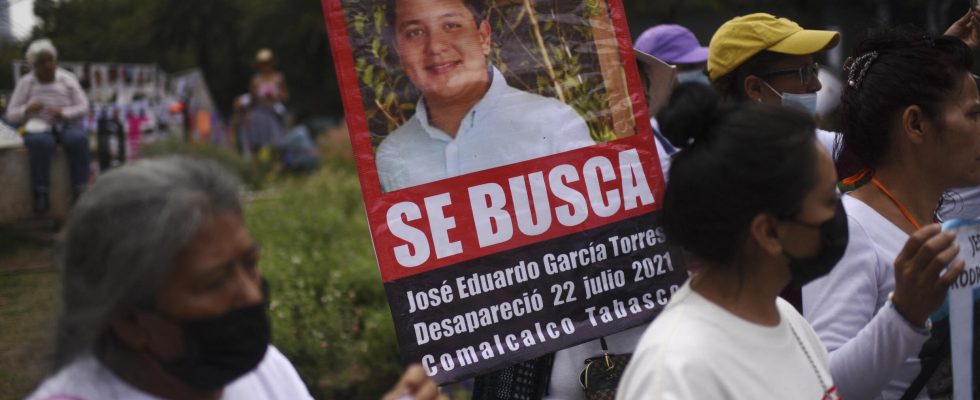The Mexican government presented a report on Thursday, December 14, according to which it had located 16,681 people missing in a national registry which includes more than 110,000 cases, the vast majority since 2006 in the midst of the violence of drug trafficking. The number of missing people immediately sparked a number of criticisms accusing the government of having redacted the list.
5 mins
President Andrés Manuel López Obrador announced a few months ago that the national register of disappearances would be revised in detail on the grounds that it was poorly managed and/or outdated. Until Thursday morning, the register of missing persons, managed by the Government and constantly updated with data from the public prosecutor’s offices, totaled 113,322 cases.
The government examined 110,964 files accumulated until last August. After purging the national database since last May, which has recorded cases since 1961, we found that “ out of 110,964 files (of disappearances), 15% have already been located “, declared Thursday the Secretary of State for the Interior, Luisa María Alcalde, at the presidential conference. The verification process is not complete and will be reported bi-monthly.
Criticisms of associations of the missing
The process has been the target of criticism from human rights activists, opposition politicians and groups of relatives of the disappeared, who accuse the government of seeking to reduce the number of missing people. “ We don’t erase anyone”assured the president.
To establish its list, the government examined official documents, such as tax payments, health or school services, among others, to determine if there were signs of life of the missing.
Luisa María Alcalde explained that she had found reliable evidence on the fate of 16,681 people. Of these, 3,945 were found at their homes and 8,405 have proof of life provided by local authorities. They also found that 197 people are imprisoned and 4,134 have died. And ” there are important indications on the location » of 17,843 other people, reported in the same missing persons database.
According to the government, out of more than 110,000 cases examined, only 12,377 (11%) are likely to be cases of disappearance, as they are being investigated by local prosecutors.
Karla Quintana, former head of the National Commission for the Search for Missing Persons, resigned last August due to disagreements over how the register was updated.
💬 “We have 111 thousand missing persons, more than 100 thousand missing persons in México 🇲🇽 and society does not respond”… During our participation in ⚖️ Diálogos sobre Justicia y Seguridad, la Excomisionada Nacional de Búsqueda de Personas, @kiquintahizo énfasis en la… pic.twitter.com/3tc2zUkjvd
— JusticiaTV (@JusticiaTV_MX) December 8, 2023
The difficulty of an exact assessment
This report was greeted with skepticism by groups of relatives of missing people consulted by the AFP because they believe that there is an under-reporting of cases because there is no complaint or because they do not are not included in official statistics.
Héctor Flores, from the organization Luz y Esperanza from the state of Jalisco (west), explained to AFP that his association brings together the relatives of around 400 people whose whereabouts are unknown, but none of whom appear in the national register. “ In 90% of disappearances, a complaint was filed, but the prosecution did not report the case to the federal government. And it can happen in other states “, did he declare. According to him, none of the members of his organization have been consulted by federal or state authorities. Jalisco, the state with the highest number of disappearances, revised its statistics through a census to estimate approximately 14,500 cases of disappearances. An underestimated figure according to some.
Read alsoMexico: clandestine graves discovered by a collective of mothers of the missing
Cecilia Floresfrom the Association Madres buscadoras from the state of Sonora and whose son disappeared in 2015, recognized that the national registry may contain inaccuracies, since his group verified that when people are located, some families prefer not to withdraw the complaint out of fear, especially if they live in areas where drug trafficking is present. “ But there is also under-recording, as many disappearances go unreported out of fear. What is needed, more than cleaning up the registry, is for the government to start doing its job: investigating and locating our missing people “, she added.
The registry includes cases since 1961, but the vast majority of disappearances have accumulated since 2006, when the federal government at the time launched a controversial military anti-drug operation. One of the most emblematic cases is the disappearance of 43 students from the Ayotzinapa normal school (Guerrero state in the south) in September 2014.
Read alsoMissing students from Ayotzinapa in Mexico: the government promises transparency that is slow to come
Just recently, on December 8, a clash took place between a criminal gang (The michoacana family) and a village militia in Texcaltitlán, in the center of the country. Fourteen people were killed and several others disappeared.
According to official figures, since December 2006, more than 420,000 murders have been recorded, most of which are victims of crime, in addition to missing persons.
(with AFP)
